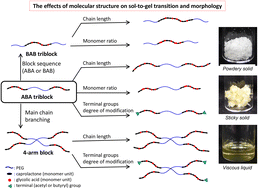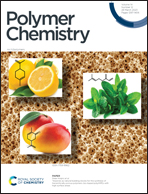A systematic study on the effects of the structure of block copolymers of PEG and poly(ε-caprolactone-co-glycolic acid) on their temperature-responsive sol-to-gel transition behavior†
Abstract
An aqueous polymer solution exhibiting a temperature-responsive sol-to-gel transition shows great potential as an injectable polymer (IP) system for biomedical materials. Block copolymers composed of biodegradable aliphatic polyesters and poly(ethylene glycol) (PEG) are known for their applications in medical devices. Their neat morphology and temperature responsiveness depend on their molecular structures, such as their main-chain architectures (linear or branched), block sequences, molecular weights, lengths of hydrophobic and hydrophilic segments, randomness of the hydrophobic copolymer segment, and terminal structures. However, systematic studies on the effects of these parameters have not yet been conducted. In this study, we synthesized ABA triblock, BAB triblock, and 4-arm branched block copolymers consisting of PEG as the hydrophilic segment and poly(ε-caprolactone-co-glycolic acid) as the hydrophobic segment with varying segment lengths, amounts of monomer (ε-caprolactone/glycolic acid) in the copolymer, and degrees of terminal modification. Their neat morphology and temperature-responsive transition behavior were analyzed. The obtained results provide molecular design guidelines for preparing biodegradable IPs that exhibit a powdery solid morphology and target-temperature gelation properties and offer the possibility of functionalization by terminal modification.

- This article is part of the themed collection: Trends in Thermoresponsive Polymers: from Chemistry to Applications


 Please wait while we load your content...
Please wait while we load your content...